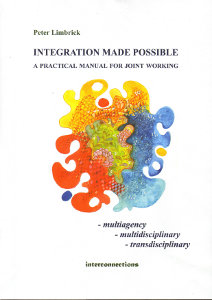Integration Made Possible: A practical manual for joint working. Multiagency - multidisciplinary - transdisciplinary
 |
Integration Made Possible: A practical manual for joint working. Multiagency - multidisciplinary - transdisciplinaryBy Peter Limbrick Published by Interconnections in March 2020 129 A4 pages. ca 20,000 words. Spiral bound. ISBN: 978-0-9576601-7-5 £30.00 (+ P&P*) Select postage:
* If purchasing mutliple books contact This email address is being protected from spambots. You need JavaScript enabled to view it. for a postage discount. From the introduction:The word ‘integration’ can be defined as unifying diverse elements into a whole. Integration is described in this Manual as a process of joining things together with the purpose of achieving something better than was there when the things were separate. When various elements of support are integrated around a baby, child, teenager, adult or elderly person, a support system is created that is more whole. Support for people in need that is unified in this way is always better than a collection of fragments that do not fit well with each other, so we can think of integration as the antidote to harmful fragmentation. This Manual takes the widest possible interpretation of integration from joint working between the major local agencies to co-operation and collaboration at community level in such facilities as swimming pools and food banks. From the back cover:Integration Made Possible With 22 pages you can photocopy for project meetings Are you passionate about integration? Would you like to see more joint working around adults and children who have special needs? Integration projects require leadership Leaders are passionate about joint working and committed to help bring about change. This Manual offers essential help In understanding important issues around integration. Discussion topics include: Starting out, Types of integration, Problems caused by fragmentation, When integration is needed, Integration that occurs spontaneously, Benefits to service users, Benefits to family, carers and friends, Benefits to service providers, Co-location and one-stop shops, Keyworking, Individualised multidisciplinary teams, Primary interventionists, Integrated pathways, Directories and communication systems, Partnership with service users, User and practitioner surveys, Horizontal teamwork, Attitudes to integration, Integration with the private sector, Integration as a cultural phenomenon, Academic responsibilities in integration, Tasks for leaders. |

